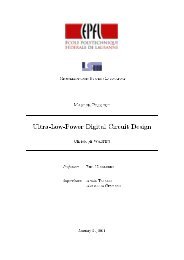Compressive Sensing system for recording of ECoG signals in-vivo
Compressive Sensing system for recording of ECoG signals in-vivo
Compressive Sensing system for recording of ECoG signals in-vivo
You also want an ePaper? Increase the reach of your titles
YUMPU automatically turns print PDFs into web optimized ePapers that Google loves.
y specially consider<strong>in</strong>g the <strong>in</strong>tegration capacitances which are necessary <strong>in</strong> each <strong>of</strong> the paths,and which widely <strong>in</strong>crease the total area <strong>of</strong> a channel, which <strong>in</strong> composed <strong>of</strong> M paths.Depend<strong>in</strong>g on the capacitances <strong>of</strong> the <strong>in</strong>tegrators, which can be large to correctly implement the<strong>in</strong>tegration at these frequencies, the complete channel could be implemented o n chip <strong>in</strong> asav<strong>in</strong>g area way. In Chapter 6, it is submitted the new proposal <strong>for</strong> the mixer-<strong>in</strong>tegrator pair <strong>of</strong>each <strong>of</strong> the paths.4. Random Matrix GenerationAlong the previous chapters, the necessity <strong>of</strong> a measurement matrix as much <strong>in</strong>coherent aspossible with respect<strong>in</strong>g to the sparsify<strong>in</strong>g basis has been shown. Different k<strong>in</strong>ds <strong>of</strong>implementations <strong>of</strong> the random matrix have been considered <strong>in</strong> [1, 3, 21, 22, 34, 35, 36]. A newrandom matrix implementation has been researched <strong>in</strong> order to determ<strong>in</strong>e which is the lowestpower cost, less area consum<strong>in</strong>g approach and overall the one which leads to the largestnumber <strong>of</strong> parallelized outputs, which, as it is <strong>in</strong>troduced <strong>in</strong> 4.2.2.3, is an <strong>in</strong>terest<strong>in</strong>g capability tobe applied <strong>in</strong> multichannel signal acquisition implementations.Ma<strong>in</strong> approaches to the obta<strong>in</strong><strong>in</strong>g <strong>of</strong> random sequences generation are the True RandomNumber Generation, (TRNG), based on analog doma<strong>in</strong>, and the Pseudorandom B<strong>in</strong>aryGeneration, (PRBS), and mostly based on digital doma<strong>in</strong>. Analog random generation is <strong>in</strong>cluded<strong>in</strong> Appendix C, regard<strong>in</strong>g to digital implementation, it is <strong>in</strong>cluded below.4.1. Digital Implementation: Pseudo Random B<strong>in</strong>ary SequencePseudorandom Random B<strong>in</strong>ary Sequence circuits (PRBS) per<strong>for</strong>m an alternative architecturewhich sacrifices true randomness generation <strong>for</strong> simplicity <strong>in</strong> the implementation, giv<strong>in</strong>g rise tomore feasible design which has a known period <strong>of</strong> randomness, after which the same sequenceis repeated. In any case if the random sequence is long enough not to be repeated dur<strong>in</strong>g thecircuits operation, this procedure constitutes an optimal solution. Hence<strong>for</strong>ward dur<strong>in</strong>g thischapter, ma<strong>in</strong> properties <strong>of</strong> PRBS as well as methodologies <strong>of</strong> function<strong>in</strong>g are discussed.4.1.1. Basics <strong>of</strong> PRB: Serial and Parallel ImplementationConventional PRBS are based <strong>in</strong> L<strong>in</strong>ear Feedback Shift Registers (LFSR), which consist <strong>of</strong> asequence <strong>of</strong> DFF which are connected is <strong>in</strong> series or <strong>in</strong> parallel by us<strong>in</strong>g XOR gates. Theposition <strong>of</strong> the XOR gates, which are called taps <strong>of</strong> the LFSR, varies depend<strong>in</strong>g <strong>of</strong> the length <strong>of</strong>the random sequence to be achieved.39















